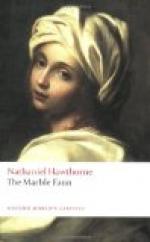The family, be it observed, were both proud and ashamed of these legends; but whatever part of them they might consent to incorporate into their ancestral history, they steadily repudiated all that referred to their one distinctive feature, the pointed and furry ears. In a great many years past, no sober credence had been yielded to the mythical portion of the pedigree. It might, however, be considered as typifying some such assemblage of qualities—in this case, chiefly remarkable for their simplicity and naturalness—as, when they reappear in successive generations, constitute what we call family character. The sculptor found, moreover, on the evidence of some old portraits, that the physical features of the race had long been similar to what he now saw them in Donatello. With accumulating years, it is true, the Monte Beni face had a tendency to look grim and savage; and, in two or three instances, the family pictures glared at the spectator in the eyes like some surly animal, that had lost its good humor when it outlived its playfulness.
The young Count accorded his guest full liberty to investigate the personal annals of these pictured worthies, as well as all the rest of his progenitors; and ample materials were at hand in many chests of worm-eaten papers and yellow parchments, that had been gathering into larger and dustier piles ever since the dark ages. But, to confess the truth, the information afforded by these musty documents was so much more prosaic than what Kenyon acquired from Tomaso’s legends, that even the superior authenticity of the former could not reconcile him to its dullness. What especially delighted the sculptor was the analogy between Donatello’s character, as he himself knew it, and those peculiar traits which the old butler’s narrative assumed to have been long hereditary in the race. He was amused at finding, too, that not only Tomaso but the peasantry of the estate and neighboring village recognized his friend as a genuine Monte Beni, of the original type. They seemed to cherish a great affection for the young Count, and were full of stories about his sportive childhood; how he had played among the little rustics, and been at once the wildest and the sweetest of them all; and how, in his very infancy, he had plunged into the deep pools of the streamlets and never been drowned, and had clambered to the topmost branches of tall trees without ever breaking his neck. No such mischance could happen to the sylvan child because, handling all the elements of nature so fearlessly and freely, nothing had either the power or the will to do him harm.
He grew up, said these humble friends, the playmate not only of all mortal kind, but of creatures of the woods; although, when Kenyon pressed them for some particulars of this latter mode of companionship, they could remember little more than a few anecdotes of a pet fox, which used to growl and snap at everybody save Donatello himself.




